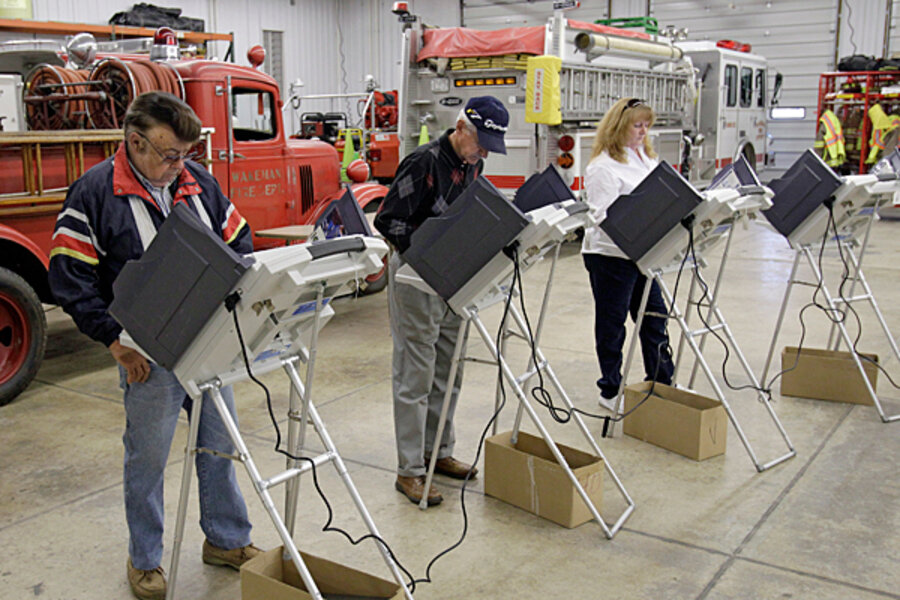Election Day in Ohio is a test for labor unions nationwide
Loading...
Ohio voters are casting ballots today on a question of nationwide significance: whether public-sector labor unions should have their power curbed in an era of fiscal austerity.
The ballot measure, called "Issue 2," represents a referendum on a law already passed by the Ohio legislature and signed by Republican Gov. John Kasich on March 31. Once the law was passed, labor unions mounted a drive for signatures to challenge the law by referendum. Implementation of the law has been put on hold pending the outcome of Tuesday's vote.
Although motivated by opposition to the law, the ballot measure is set up so that a "yes" vote would leave the law intact, while labor union supporters are urging Ohioans to vote "no."
The vote comes as states and localities nationwide are wrestling with tight budgets, and as some other states have moved to curb union bargaining power. Notably, Wisconsin Gov. Scott Walker and the Republican legislature there passed labor restrictions despite weeks of protests by Democratic lawmakers and union supporters.
Moves on union-related matters such as public-employee health-care costs and teacher tenure have also cropped up in states as diverse as Massachusetts, Indiana, Nevada, and Florida.
Amid a nationwide focus on such questions, the Ohio referendum could send important signals. Polls taken before the vote suggest that a majority of Ohioans side with the view of labor unions. And a majority of voters in one poll say they disapprove of Mr. Kasich's performance as governor.
If the Ohio vote goes labor's way, it won't necessarily signal a nationwide change in momentum on the issue. For one thing, the labor movement has stronger roots in Ohio than in many other states. Also, the Ohio law represents just one approach to placing new limits on public-sector unions – an approach that many state voters found distasteful. (The law effectively eliminates the right to strike, for example.)
But a "no" vote on the law would provide a big boost to organized labor, with a win that could help energize its union ranks nationwide. It would send a signal that unions can win some key battles, although they have failed so far to overturn a similar law in Wisconsin.
In the run-up to Tuesday's vote, supporters and foes of the law spent big money sparring fiercely over the merits of the the Ohio law, known as Senate Bill 5 (SB5).
John Glenn, the former astronaut who served as a Democratic US Senator from the state, appeared in an ad siding with labor. The editorial board of Cleveland's major newspaper, the Plain Dealer, sided with Republicans even while saying the law went too far in some respects.
"Polls consistently show that Ohioans like many aspects of Senate Bill 5, but not the nasty tone behind it," the editorial stated. Yet it concluded that Ohio "desperately needs to control the costs of government at all levels," and that the law would enable important steps in that direction.
The law would require public employees to contribute toward their health and pension benefits on a scale more similar to private-sector workers, while allowing collective bargaining over wages to continue. It would require that pay be based partly on performance. And it would allow layoffs to be based on factors beyond seniority.
The measure also contains a controversial ban on public-employee unions collecting "fair share" dues from employees who benefit from union bargaining without joining the union. Where supporters cite the principle of worker rights, critics see a political effort to bust the political power of unions.
In nationwide Gallup polls this year, Americans have shown ambivalent views on labor unions.
In March, some 49 percent said states should limit collective bargaining power to help balance budgets, while 45 percent disliked that idea. And 62 percent supported cuts in the size of state workforces. Meanwhile, a sizable majority opposed the option of raising state taxes.
In August, 52 percent of Americans said they approve of labor unions. But that number is historically low (it was 60 percent in the early 1990s and about 70 percent in the early 1960s), and respondents to the poll were more likely to say that unions hurt the economy than help it.





